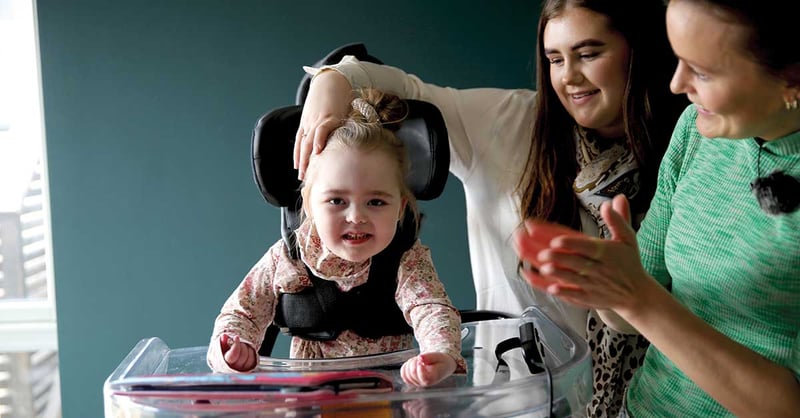When is postural support needed to control the head and what to use?


For children, young people and adults with complex needs, a wide range of postural equipment is needed for positioning. In some cases, support of the neck and head is also required, to enable and sustain an upright position of the head.
In this article you can read about:
- Development of head control
- Why is head control so important
- Limited head control in people with disabilities
- Postural support to assist head control
- What is a Neck Collar?
- Who is it for?
- What are the benefits?
Development of head control
Head control a is one of the earliest motor developmental skills that an infant acquires. Head control is a basic skill and a driver for motor development. A newborn baby is not able to control its head and need a lot of support when lifted and carried around. A newborn mainly turns his/her head to the sides when back lying, due to the size of the head in relation to the body and because the neck muscles have not yet developed strength.
By the age of 2 months a baby will try to lift the head when lying on the tummy and may also try to turn the head to the sides. Around 3 months the baby have gain more control and can lift up the head and upper part of the chest with the hands when lying on the tummy. Closer to 4 months the baby is able to hold the head in supported sitting. Between 4 to 6 months of age there is a dramatic development of motor control, and she/he will roll and even start to push into sitting position. The head control is good now and new motor skills are gained rapidly.
Read more: Comfort and development – Striking a balance with assistive technology
Why is head control so important?
Head control play an important role in the development of postural control and motor development. Head control enables visual orientation, and they reinforce each other. The baby is turning its head to follow the mother or father who is moving in the room or looking at a toy lying close by. The muscles are challenged and strengthen. Vision and head control is improved.
Head control also influence communication. This is a consequence of respiratory control, empowering the speech and the ability to take in more information from the environment around. It also affects feeding with solid food. The neck and trunk are stronger, and the position of the cheeks change.
Disturbed head control in people with disabilities
Disturbed head control is often related to an overall affected motor function. People with disabilities such as cerebral palsy and especially with more severe variants, like GMFCS IV and V (Gross Motor Function Classification System) struggle to keep the body in an aligned position especially while in sitting and standing against gravity. This also include limited control of the head.
People with severely disturbed motor function is often in need of postural support from assistive technology to keep a position. Type of equipment needed is depending on intended purpose or activity, but typically include seating systems, manual or electrical wheelchairs, static or dynamic standing equipment, gait trainers or walkers etc.
The purpose of postural support equipment is to assist an appropriate position that enables function, participation and activity. It should allow the person to be more independent, empower mobility, ease communication and enable a good position for basic needs like breathing and eating. Equipment also intends to position the person to limited secondary outcomes that may occur for people with severe disabilities over time, such as deformities and contractures.
Positioning of the head is complex and closely related to positioning of the entire body. Assistive technology often has a standard solution to support the head, and, in many cases, reclined position can be enough to stabilise the head in an appropriate position. In some cases, special designed equipment for head control is required to accomplish a good position of the head.
Postural support to assist head control
Most commonly the support of the head is required in sitting and/or in standing position, where gravity impacts mostly on head control.
Your responsible occupational therapist or physiotherapist will together with you assess individual needs and help you to decide on type of equipment needed and where and when to use it.
The Neck Collar is a type of support to assist head control. The great benefit of this devices is that it can easily be used in combination with different equipment, and you can switch it between products.
What is a Neck Collar?
The Neck Collar is like the Headaloft supporting the head in a neutral position. The difference is that the Neck Collar is attached around the neck of your child. The front chest plate push against the chest and secure that the Neck Collar stay in position and the child can support its chin on the upside part of the collar. This avoids the child’s head from falling forward and to the sides.
It is essential that the Neck Collar fits the size of your child’s neck circumference, to ensure the best support of the head. Measure your child’s neck circumference with a soft measuring tape and choose the right size. The small Neck Collar fits a neck circumference of 25-35 cm, size medium 35-45 cm and size large 45-55 cm.
Who is it for?
The Neck Collar is suitable for children, adolescent and adults with moderate to significantly reduced independent head control. It provides necessary support, without the individual being deprived of full head control.
.jpg?width=1100&height=733&name=Ludvig%20(2).jpg)
What are the benefits of the Neck Collar?
The Neck Collar provides necessary support of the head in a neutral position, avoiding the head from tipping forward or sideways due to limited muscle control and strength. A controlled position of the head in sitting and standing is important to enable activity and participation in everyday situations.
A great benefit with the Neck Collar is the ability to use it within any device in sitting and standing, as it is not attached to the device. In addition, it allows you to use it during transfer, for example when hoisting your child from seated in the wheelchair to standing in a standing frame or in the Innowalk. Transfer situations can be challenging when the child have limited head control and often demands more hands, but by using the Neck Collar the transfer situation becomes more comfortable and safe for both the child and you.
Comfort is essential when wearing a collar around your neck. Therefore, the cover on the Neck Collar is made in a soft material and all stitches are not in touch with the head and neck. The inner foam is firm to ensure stability, but the top layer of the Neck Collar which is in contact with the child’s chin and jaw is made of a softer material. The combination of the soft cover and top layered soft form ensure good comfort during use. For hygiene reasons the cover can easily be removed, and machine washed.
The Neck Collar has a Velcro strap at the back and is easy to put on and take off and also allow you to adjust tightness within each size.

Rikke Damkjær Moen brings many years of experience as clinical physiotherapist to the Made for Movement team. Her mission is to ensure that everybody, regardless of mobility problems, should be able to experience the joy and health benefits of physical activity. As our Medical Manager, Rikke is passionate about sharing knowledge so that individuals with special needs, families, and clinicians can discover the possibilities and solutions provided by Made for Movement.
It's a very special story marked by love, effort, and unstoppable determination. It's about Tom and his family. In the interview,...
A severe accident during a hockey game resulted in 35-year-old Tobias breaking his neck and becoming paralysed from the armpits down....
A disability entails the loss of, damage to, or deviation from bodily or psychological functions, in the form of mental, physical,...
Hear from us from time to time and learn new things
